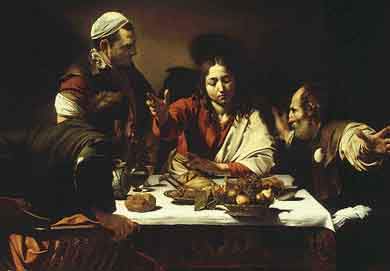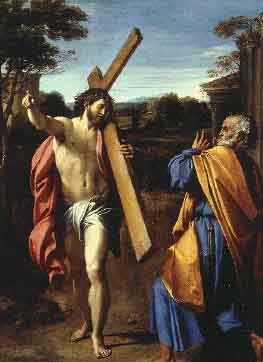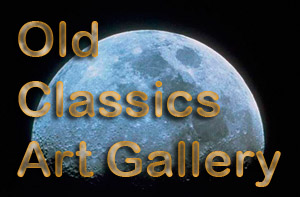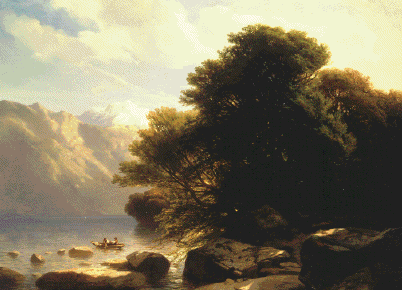| |
|
 |
The Supper at Emmaus
Composition
Looking at the painting,
we
are invited to participate
in the drama across the fourth side of
the table with Christ
the only figure facing us.
Caravaggio uses the receding
table to help plot the
space inside the picture.
The disciples’ arms confine
the space at the side.
Their motion helps draw
us in.
Christ appearing to St
Peter
Annibale CARRACCI (NG)
Detail
The foreshortened arm
almost comes out of the picture.
Caravaggio probably developed
this idea from works
he saw in Rome by artists
such as Annibale Carracci. |
|
Christ appearing
to St Peter
Annibale CARRACCI
Painted 1601-2
Full title ‘Christ appearing
to Saint Peter on the Appian Way (Domine Quo Vadis?)’
Wood, 77.4 x 56.3 cm No.
9, Purchased, 1826.
The incident is traditional
but not very common in painting. During the
persecutions under Nero,
St Peter fled from Rome and on the Appian Way
encountered a vision of
Christ bearing his Cross. In answer to St Peter's question
'Lord, where goest thou?',
Christ said he was going to Rome to be crucified
a second time; St Peter
thereupon turned back and later suffered
martyrdom there.Painted
in 1601-2, the work was almost certainly commissioned by
or on behalf of Cardinal
Pietro Aldobrandini, in whose collection it is recorded in 1603.
|
 |
|
Annibale Carracci
(Bologna, November 3, 1560 - Rome, July 15, 1609 was a prominent Italian
Baroque painter
Annibale in all likelihood
first apprenticed within his family. In 1582, Annibale, his brother Agostino,
and his cousin Ludovico Carracci opened a painter's studio, called by some
initially as the Academy of Desiderosi (Desirous of fame and learning)
or subsequently of the Incamminati (progressives; literally "of those opening
a new way"). While the Carraccis laid emphasis on the typically Florentine
linear draftsmanship, as exemplified by Raphael and Andrea del Sarto, their
style also derived from Venetian painters an attention to the glimmering
colors and mistier edge of objects. This eclecticism would define artists
of the Baroque Emilian or Bolognese School.
It is difficult to distinguish
the individual contributions by each Carracci in many early works in Bologna.
For example, the frescoes on the story of Jason for the Palazzo Fava in
Bologna (c. 1583-84); the frescoes are signed by Carracci and state that
they all contributed. In 1585, Annibale completed an altarpiece of the
Baptism of Christ for the church of San Gregorio in Bologna. In 1587, he
painted the Assumption for the church of San Rocco in Reggio Emilia.
In 1587-88, Annibale is
known to have have traveled to Parma and then Venice, where he met up with
his brother Agostino. From 1589-92, the three Carracci complete the frescoes
on the Founding of Rome for the Palazzo Magnani in Bologna. By 1593, Annibale
completed by an altarpiece, Virgin on the throne with St John and St Catherine,
working alongside with Lucio Massari. His Resurrection of Christ also dates
from the year 1593. In 1592, he paints an Assumption for the Bonasoni chapel
in San Francesco. During 1593-1594, all three Carracci work at frescoes
in the Palazzo Sampieri in Bologna.
|





